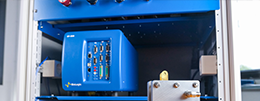Optimising zinc sacrificial anode configurations for corrosion protection in patch-repaired reinforced concrete Slabs: Experimental insights and underlying electrochemical mechanisms
Latest updated: September 26, 2025DOI: https://doi.org/10.1016/j.jobe.2025.112915
Authors: Huy Tang Bui, Kang Hai Tan
Abstract
Patching is one of the most commonly used methods to repair spalled concrete caused by steel bar corrosion. However, cracks frequently reappear in the surrounding patched areas within a few months due to macrocell corrosion. To mitigate this issue, sacrificial anode cathodic protection (SACP) has emerged as a promising technique. This study presents an experimental investigation into the corrosion kinetics of reinforced concrete (RC) slabs subjected to four different repair configurations: (1) patch repair without sacrificial anodes; (2) patch repair with a single large zinc anode placed at the centre of the repair area; (3) patch repair with multiple zinc anodes, having the same total surface area as in (2), distributed along the repair boundary within the patch mortar; and (4) patch repair with the same zinc anodes as in (3) but positioned outside the patch mortar. The results indicate that the most effective macrocell corrosion protection was achieved when the zinc anode was divided into multiple smaller pieces and embedded in the concrete substrate along the repair boundary. In contrast, embedding zinc anodes within the patch mortar, as in configuration (3), led to a reduction in protection efficacy, while configuration (2) exhibited the lowest effectiveness. Notably, the patch repair specimen without zinc anodes experienced the most severe macrocell corrosion. However, zinc anode cathodic protection, regardless of the configuration, did not significantly influence microcell corrosion in the repaired RC slabs. To further elucidate the experimental findings, an electrochemical mechanism was proposed, considering the anodic and cathodic polarisation kinetics of both corroded and uncorroded steel bars, as well as the behaviour of zinc sacrificial anodes.





